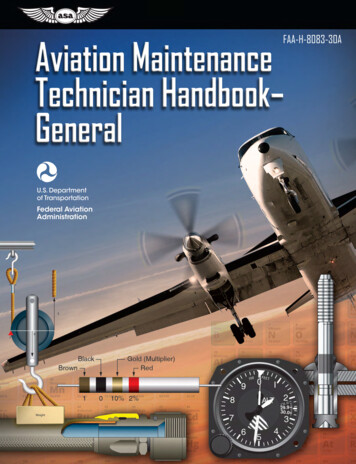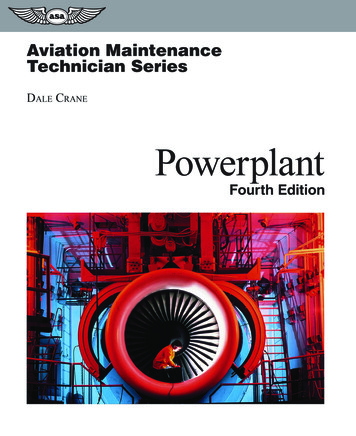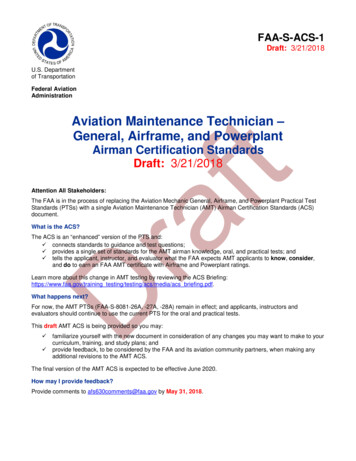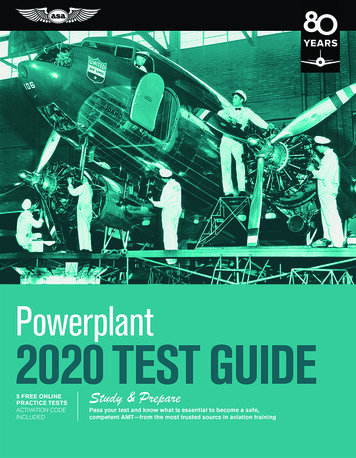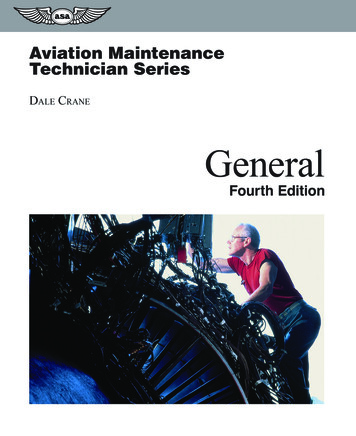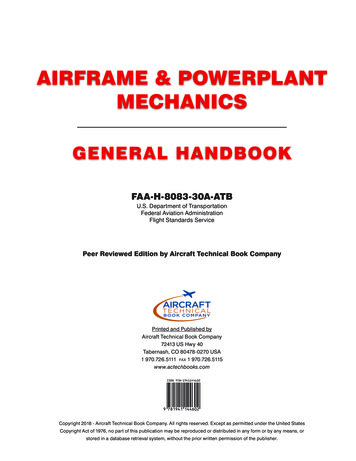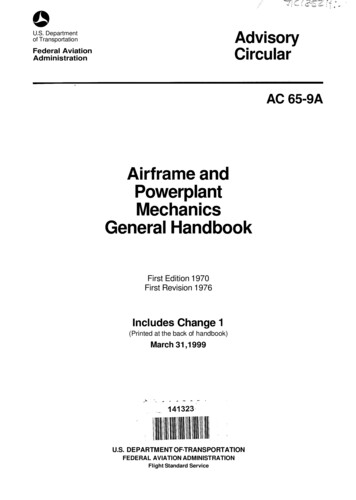
Transcription
Volume ContentsVolume 1Volume 2Preface.vChapter 6Lubrication and Cooling Systems.6-1Acknowledgments.viiTable of Contents.ixChapter 7Propellers.7-1Chapter 1Aircraft Engines.1-1Chapter 8Engine Removal and Replacement.8-1Chapter 2Engine Fuel and Fuel Metering Systems.2-1Chapter 9Engine Fire Protection Systems.9-1Chapter 3Induction and Exhaust Systems.3-1Chapter 10Engine Maintenance and Operation.10-1Chapter 4Engine Ignition and Electrical Systems.4-1Chapter 11Light-Sport Aircraft Engines.11-1Chapter 5Engine Starting Systems.5-1iii
PrefaceThe Aviation Maintenance Technician Handbook–Powerplant (FAA-H-8083-32A) is one of a series of three handbooks forpersons preparing for certification as a powerplant mechanic. It is intended that this handbook provide the basic informationon principles, fundamentals, and technical procedures in the subject matter areas relating to the powerplant rating. It isdesigned to aid students enrolled in a formal course of instruction, as well as the individual who is studying on his or herown. Since the knowledge requirements for the airframe and powerplant ratings closely parallel each other in some subjectareas, the chapters which discuss fire protection systems and electrical systems contain some material which is also duplicatedin the Aviation Maintenance Technician Handbook–Airframe (FAA-H-8083-31A).This handbook contains an explanation of the units that make up each of the systems that bring fuel, air, and ignition togetherin an aircraft engine for combustion. It also contains information on engine construction features, lubrication systems, exhaustsystems, cooling systems, cylinder removal and replacement, compression checks, and valve adjustments. Because thereare so many different types of aircraft in use today, it is reasonable to expect that differences exist in airframe componentsand systems. To avoid undue repetition, the practice of using representative systems and units is carried out throughoutthe handbook. Subject matter treatment is from a generalized point of view and should be supplemented by reference tomanufacturer's manuals or other textbooks if more detail is desired. This handbook is not intended to replace, substitutefor, or supersede official regulations or the manufacturer’s instructions. Occasionally the word “must” or similar languageis used where the desired action is deemed critical. The use of such language is not intended to add to, interpret, or relievea duty imposed by Title 14 of the Code of Federal Regulations (14 CFR).This handbook is available for download, in PDF format, from www.faa.gov.The subject of Human Factors is contained in the Aviation Maintenance Technician Handbook–General (FAA-H-8083-30).This handbook is published by the United States Department of Transportation, Federal Aviation Administration, AirmanTesting Standards Branch, AFS-630, P.O. Box 25082, Oklahoma City, OK 73125.Comments regarding this publication should be sent, in email form, to the following address:AFS630comments@faa.govv
AcknowledgmentsThe Aviation Maintenance Technician Handbook–Powerplant (FAA-H-8083-32A) was produced by the Federal AviationAdministration (FAA) with the assistance of Safety Research Corporation of America (SRCA). The FAA wishes to acknowledgethe following contributors:Mr. Tom Wild for images used throughout this handbookFree Images Live (www.freeimageslive.co.uk) for image used in Chapter 1Mr. Stephen Sweet (www.stephensweet.com) for image used in Chapter 1Mr. Omar Filipovic (www.glasair-owners.com) for image used in Chapter 1Mr. Warren Lane (Atomic Metalsmith, Inc.) for image used in Chapter 1Pratt & Whitney for images used in Chapters 2, 3, 6, 7, and 8Teledyne Continental Motors (www.genuinecontinental.aero) for images used in Chapters 2, 3, and 11Aircraft Tool Supply Company (www.aircraft-tool.com) for images used in Chapter 4Chief Aircraft (www.chiefaircraft.com) for images used in Chapter 4DeltaHawk Engines, Inc. (www.deltahawkengines.com) for image used in Chapter 6Mr. Felix Gottwald for image used in Chapter 7Mr. Stephen Christopher (www.schristo.com) for images used in Chapter 8Mr. Yunjin Lee for images used in Chapter 9Mr. Marco Leerentveld (www.flightillusion.com ) for image used in Chapter 10Aeromax Aviation, LLC (www.aeromaxaviation.com) for images used in Chapter 11Avid Aircraft (www.avidflyeraircraft.com) for image used in Chapter 11Flight and Safety Design (www.eco1aircraft.com) for image used in Chapter 11Great Plains Aircraft Supply Co., Inc. (www.greatplainsas.com) for image used in Chapter 11Lycoming Engines (www.lycoming.textron.com) for image used in Chapter 11Revmaster LLC Aviation (revmasteraviation.com) for images used in Chapter 11Rotech Research Canada, Ltd. (www.rotec.com) for images used in Chapter 11Additional appreciation is extended to Mr. Gary E. Hoyle, Dean of Students, Pittsburgh Institute of Aeronautics; Mr. TomWild, Purdue University; Dr. Ronald Sterkenburg, Associate Professor of the Department of Aviation Technology, PurdueUniversity; for their technical support and input.vii
Volume 12018U.S. Department of TransportationFEDERAL AVIATION ADMINISTRATIONFlight Standards ServiceVOLUME 1Aviation Maintenance TechnicianHandbook–Powerplant
Table of ContentsVolume Contents. VPreface. VIIAcknowledgments. IXTable of Contents. XIChapter 1Aircraft Engines.1-1General Requirements.1-1Power and Weight.1-2Fuel Economy.1-3Durability and Reliability.1-3Operating Flexibility.1-3Compactness.1-3Powerplant Selection.1-3Types of Engines.1-4Inline Engines.1-4Opposed or O-Type Engines.1-4V-Type Engines.1-5Radial Engines.1-5Reciprocating Engines.1-5Design and Construction.1-5Crankcase Sections.1-5Accessory Section.1-7Accessory Gear Trains.1-7Crankshafts.1-8Crankshaft Balance.1-10Dynamic Dampers.1-10Connecting Rods.1-10Master-and-Articulated Rod Assembly.1-11Knuckle Pins.1-12Plain-Type Connecting Rods.1-12Fork-and-Blade Rod Assembly.1-12Pistons.1-12Piston Construction.1-12Piston Pin.1-13Piston Rings.1-14Piston Ring Construction.1-14Compression Ring.1-14Oil Control Rings.1-14Oil Scraper Ring.1-14Cylinders.1-14Cylinder Heads.1-15Cylinder Barrels.1-16Cylinder Numbering.1-16Firing Order.1-16Single-Row Radial Engines.1-16Double-Row Radial Engines.1-17Valves.1-17Valve Construction.1-17Valve Operating Mechanism.1-18Cam Rings.1-19Camshaft.1-20Tappet Assembly.1-20Solid Lifters/Tappets.1-21Hydraulic Valve Tappets/Lifters.1-21Push Rod.1-21Rocker Arms.1-22Valve Springs.1-22Bearings.1-22Plain Bearings.1-23Ball Bearings.1-23Roller Bearings.1-23Propeller Reduction Gearing.1-24Propeller Shafts.1-24Reciprocating Engine Operating Principles.1-24Operating Cycles.1-26Four-Stroke Cycle.1-26Intake Stroke.1-27Compression Stroke.1-27Power Stroke.1-27Exhaust Stroke.1-28Two-Stroke Cycle.1-28Rotary Cycle.1-28Diesel Cycle.1-28Reciprocating Engine Power and Efficiencies.1-28Work.1-28Horsepower.1-28Piston Displacement.1-291-iii
Area of a Circle.1-29Example.1-29Compression Ratio.1-29Indicated Horsepower.1-31Example.1-32Brake Horsepower.1-32Example.1-33Friction Horsepower.1-33Friction and Brake Mean Effective Pressures.1-33Thrust Horsepower.1-35Efficiencies.1-35Thermal Efficiency.1-35Example.1-35Mechanical Efficiency.1-36Volumetric Efficiency.1-36Propulsive Efficiency.1-37Gas Turbine Engines .1-37Types and Construction.1-37Air Entrance.1-38Accessory Section.1-38Compressor Section.1-39Compressor Types.1-40Centrifugal-Flow Compressors.1-40Axial-Flow Compressor.1-41Diffuser.1-44Combustion Section.1-44Turbine Section.1-47Exhaust Section.1-52Gas Turbine Engine Bearings and Seals.1-53Turboprop Engines.1-56Turboshaft Engines.1-56Turbofan Engines.1-57Turbine Engine Operating Principles.1-57Thrust.1-59Gas Turbine Engine Performance.1-60Ram Recovery.1-62Chapter 2Engine Fuel and Fuel Metering Systems.2-1Fuel System Requirements.2-1Vapor Lock.2-2Basic Fuel System.2-2Fuel Metering Devices for Reciprocating Engines.2-3Fuel/Air Mixtures.2-4Carburetion Principles.2-5Venturi Principles.2-5Application of Venturi Principle to Carburetor.2-6Metering and Discharge of Fuel.2-6Carburetor Systems.2-8Carburetor Types.2-9Carburetor Icing.2-91-ivFloat-Type Carburetors.2-10Float Chamber Mechanism System.2-10Main Metering System.2-11Idling System.2-12Mixture Control System.2-13Accelerating System.2-14Economizer System.2-14Pressure Injection Carburetors.2-15Typical Injection Carburetor.2-15Throttle Body.2-16Regulator Unit.2-16Fuel Control Unit.2-18Automatic Mixture Control (AMC).2-19Stromberg PS Carburetor.2-20Accelerating Pump.2-21Manual Mixture Control.2-21Fuel-Injection Systems.2-22Bendix/Precision Fuel-Injection System.2-22Fuel Injector.2-22Airflow Section.2-22Regulator Section.2-22Fuel Metering Section.2-23Flow Divider.2-23Fuel Discharge Nozzles.2-24Continental/TCM Fuel-Injection System.2-25Fuel-Injection Pump.2-25Fuel/Air Control Unit.2-27Fuel Control Assembly.2-27Fuel Manifold Valve.2-28Fuel Discharge Nozzle.2-28Carburetor Maintenance.2-30Carburetor Removal.2-30Installation of Carburetor.2-30Rigging Carburetor Controls.2-30Adjusting Idle Mixtures.2-30Idle Speed Adjustment.2-32Fuel System Inspection and Maintenance.2-32Complete System.2-33Fuel Tanks.2-33Lines and Fittings.2-33Selector Valves.2-33Pumps.2-33Main Line Strainers.2-34Fuel Quantity Gauges.2-34Fuel Pressure Gauge.2-34Pressure Warning Signal.2-34Water Injection Systems forReciprocating Engines.2-34Turbine Engine Fuel System—GeneralRequirements.2-34Turbine Fuel Controls.2-35
Hydromechanical Fuel Control.2-35Hydromechanical/Electronic Fuel Control.2-35FADEC Fuel Control Systems.2-37FADEC for an Auxiliary Power Unit.2-37FADEC Fuel Control Propulsion Engine.2-39Fuel System Operation.2-41Water Injection System.2-41Fuel Control Maintenance.2-42Engine Fuel System Components.2-43Main Fuel Pumps (Engine Driven).2-43Fuel Heater.2-43Fuel Filters.2-44Fuel Spray Nozzles and Fuel Manifolds.2-45Simplex Fuel Nozzle.2-46Duplex Fuel Nozzle.2-46Airblast Nozzles.2-46Flow Divider.2-46Fuel Pressurizing and Dump Valves.2-47Combustion Drain Valves.2-47Fuel Quantity Indicating Units.2-48Chapter 3Induction and Exhaust Systems.3-1Reciprocating Engine Induction Systems.3-1Basic Carburetor Induction System.3-2Induction System Icing.3-4Induction System Filtering.3-5Induction System Inspection and Maintenance.3-5Induction System Troubleshooting.3-5Supercharged Induction Systems.3-5Internally Driven Superchargers.3-6Turbosuperchargers.3-8Normalizer Turbocharger.3-11Ground-Boosted Turbosupercharger System.3-11A Typical Turbosupercharger System.3-13Turbocharger Controllers and SystemDescriptions.3-15Variable Absolute Pressure Controller (VAPC).3-16Sloped Controller.3-16Absolute Pressure Controller.3-17Turbocharger System Troubleshooting.3-17Turbine Engine Inlet Systems.3-17Divided-Entrance Duct.3-19Variable-Geometry Duct.3-19Compressor Inlet Screens.3-20Bellmouth Compressor Inlets.3-20Turboprop and Turboshaft Compressor Inlets.3-21Turbofan Engine Inlet Sections.3-21Reciprocating Engine Exhaust Systems.3-22Radial Engine Exhaust Collector Ring System.3-23Manifold and Augmentor Exhaust Assembly.3-24Reciprocating Engine Exhaust SystemMaintenance Practices.3-24Exhaust System Inspection.3-24Muffler and Heat Exchanger Failures.3-25Exhaust Manifold and Stack Failures.3-25Internal Muffler Failures.3-25Exhaust Systems with Turbocharger.3-26Augmentor Exhaust System.3-26Exhaust System Repairs.3-26Turbine Engine Exhaust Nozzles.3-26Convergent Exhaust Nozzle.3-28Convergent-Divergent Exhaust Nozzle.3-28Thrust Reversers.3-28Afterburning/Thrust Augmentation.3-29Thrust Vectoring.3-31Engine Noise Suppression.3-31Turbine Engine Emissions.3-33Chapter 4Engine Ignition and Electrical Systems.4-1Reciprocating Engine Ignition Systems.4-1Magneto-Ignition System Operating Principles.4-2High-Tension Magneto System Theory ofOperation.4-2Magnetic Circuit.4-2Primary Electrical Circuit.4-4Secondary Electrical Circuit.4-6Magneto and Distributor Venting.4-7Ignition Harness.4-8Ignition Switches.4-9Single and Dual High-Tension System Magnetos.4-10Magneto Mounting Systems.4-10Low-Tension Magneto System.4-10FADEC System Description.4-12Low-Voltage Harness.4-13Electronic Control Unit (ECU).4-14PowerLink Ignition System.4-14Auxiliary Ignition Units.4-15Booster Coil.4-15Impulse Coupling.4-17High-Tension Retard Breaker Vibrator.4-18Low-Tension Retard Breaker Vibrator.4-19Spark Plugs.4-20Reciprocating Engine Ignition SystemMaintenance and Inspection.4-22Magneto-Ignition Timing Devices.4-23Built-In Engine Timing Reference Marks.4-23Timing Disks.4-24Piston Position Indicators.4-241-v
Timing Lights.4-24Checking the Internal Timing of a Magneto.4-25High-Tension Magneto E-Gap Setting(Bench Timing).4-26Timing the High-tension Magneto to the Engine.4-27Performing Ignition System Checks.4-27Ignition Switch Check.4-28Maintenance and Inspection of Ignition Leads.4-28Replacement of Ignition Harness.4-29Checking Ignition Induction Vibrator Systems.4-30Spark Plug Inspection and Maintenance.4-30Carbon Fouling of Spark Plugs.4-30Oil Fouling of Spark Plugs.4-30Lead Fouling of Spark Plugs.4-31Graphite Fouling of Spark Plugs.4-31Gap Erosion of Spark Plugs.4-32Spark Plug Removal.4-32Spark Plug Reconditioning Service.4-33Inspection Prior to Installation.4-34Spark Plug Installation.4-35Spark Plug Lead Installation.4-35Breaker Point Inspection.4-36Dielectric Inspection.4-38Ignition Harness Maintenance.4-38High-Tension Ignition Harness Faults.4-38Harness Testing.4-39Turbine Engine Ignition Systems.4-40Capacitor Discharge Exciter Unit.4-41Igniter Plugs.4-42Turbine Ignition System Inspection andMaintenance.4-42Inspection.4-43Check System Operation.4-43Repair.4-43Removal, Maintenance, and Installation ofIgnition System Components.4-43Ignition System Leads.4-44Igniter Plugs.4-44Powerplant Electrical Systems.4-45Wire Size.4-45Factors Affecting the Selection of Wire Size.4-47Factors Affecting Selection of ConductorMaterial.4-47Conductor Insulation.4-49Identifying Wire and Cable.4-50Electrical Wiring Installation.4-51Wire Groups and Bundles.4-51Twisting Wires.4-52Spliced Connections in Wire Bundles.4-52Slack in Wiring Bundles.4-52Bend Radii.4-52Routing and Installation.4-531-viProtection Against Chafing.4-53Protection Against High Temperature.4-53Protection Against Solvents and Fluids.4-54Protection of Wires in Wheel Well Area.4-54Routing Precautions.4-54Installation of Cable Clamps.4-54Lacing and Tying Wire Bundles.4-55Single-Cord Lacing.4-55Double-Cord Lacing.4-56Lacing Branch-Offs.4-56Tying.4-57Cutting Wire and Cable.4-58Stripping Wire and Cable.4-58Solderless Terminals and Splices.4-59Copper Wire Terminals.4-59Crimping Tools.4-60Aluminum Wire Terminals.4-60Splicing Copper Wires Using Preinsulated Wires.4-61Emergency Splicing Repairs.4-61Splicing with Solder and Potting Compound.4-61Connecting Terminal Lugs to Terminal Blocks.4-62Bonding and Grounding.
This handbook is available for download, in PDF format, from www.faa.gov. The subject of Human Factors is contained in the Aviation Maintenance Technician Handbook-General (FAA-H-8083-30). This handbook is published by the United States Department of Transportation, Federal Aviation Administration, Airman
